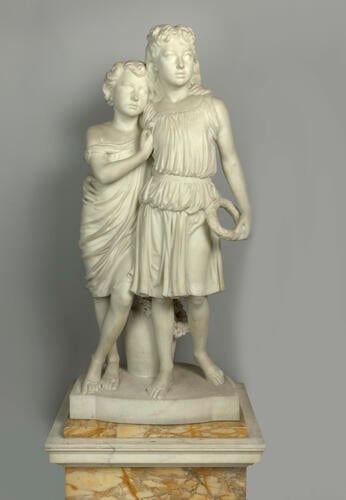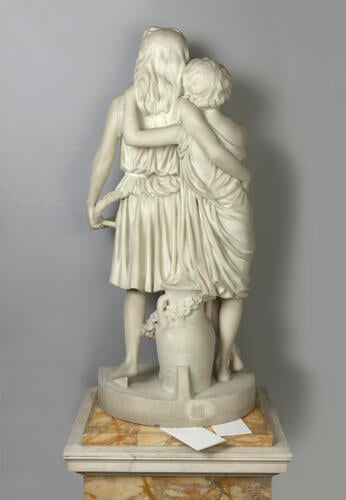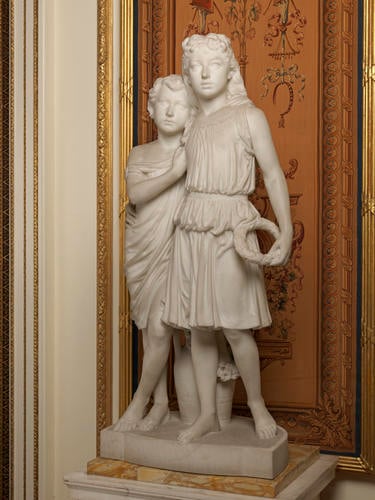-
1 of 253523 objects
Victoria (1868-1935) and Maud (1869-1938) of Wales signed & dated 1877
Marble | 137.2 cm (height) (whole object) | RCIN 2073







-
Full length marble statue of Princesses Victoria and Maud of Wales, daughters of the Prince and Princess of Wales, Edward (later Edward VII) and Alexandra of Denmark. Shown standing and looking upwards to their left, both wearing classical dress. Princess Victoria holds a wreath of laurel leaves; Maud holds a flower. Maud leans on her sister with her arm around her shoulders. Sculpture was a fashionable way to record the appearance of children. Queen Victoria was very keen to commission portraits of her children and grandchildren, both painted and sculpted. This dual portrait of her grand-daughters Victoria and Maud was probably carved for her as an addition to other statues of the Prince of Wales and Princess Alexandra’s children: Prince Albert Victor, the Duke of Clarence, Princess Louise and Prince George (later George V). It is a typical neo-classical depiction where the artist intends to portray the likeness of the sitters following the classical principles of simplicity of lines, perfecting nature and idealising the human body. The two sisters are shown standing, wearing classical tunics, in a relaxed but still formal and dignified pose. Victoria is shown holding a laurel wreath, a symbol of honour, and Maud, who is leaning on her older sister, holds a flower, often interpreted as a symbol of purity and virtuosity. Princess Victoria lived in England all her life and never married. Prince Maud, who was the youngest of Edward VII’s children, married Prince Carl of Denmark in 1896, who later became King Haakon VII of Norway. Mary Thornycroft (nee Francis) received her first royal commission in 1843 from Queen Victoria for a set of life-size marble sculptures of hands, arms and feet of the Queen’s children – the infants Victoria, the Princess Royal and Edward, the Prince of Wales. She became a favourite artist and throughout her career she made several busts and life size statues of Queen Victoria’s children, many of which were reproduced and popularised in smaller parian ware versions. Parian ware was a more affordable type of porcelain and its lower price made it more accessible for the middle classes to purchase. It is for these depictions of children that Mary Thornycroft is mostly remembered.
Provenance
Probably carved for Queen Victoria as companion to the statue of Princess Louise (RCIN 2072).
-
Creator(s)
(sculptor)(nationality)Acquirer(s)
-
Medium and techniques
Marble
Measurements
137.2 cm (height) (whole object)